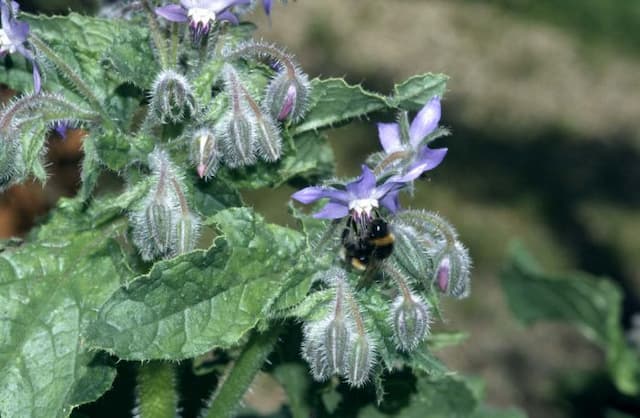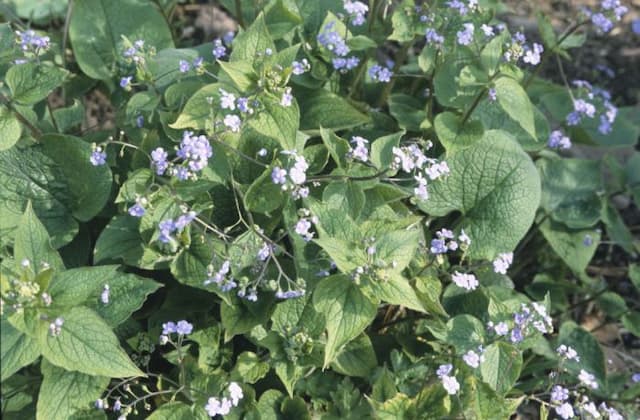Caucasian comfrey Symphytum caucasicum

ABOUT
Symphytum caucasicum, commonly known as Caucasian comfrey, displays a robust and lush appearance characterized by broad, hairy leaves that are dark green in color. The foliage is typically lance-shaped or elongated with a rough, textured surface due to the presence of small bristles. The plant is known for its striking flowers that are bell-shaped and hang in clusters from arching stems. These blossoms can come in a variety of colors including blue, purple, or creamy white. The flowering structures bring a certain charm to the plant, often attracting bees and other pollinators. The contrast between the vibrant flowers and the deep green leaves creates an attractive display in gardens where the Caucasian comfrey is grown. The stems of the plant are sturdy and covered with similar coarse hairs as the leaves. Overall, the appearance of this plant is one that suggests it is a hardy and resilient perennial, capable of enlivening a garden space with its verdant leaves and colorful flowers.
About this plant
 Names
NamesFamily
Boraginaceae
Synonyms
Caucasian Comfrey, Blue Comfrey
Common names
Symphytum asperrimum, Symphytum peregrinum, Symphytum caucasicum.
 Toxicity
ToxicityTo humans
Symphytum caucasicum, commonly known as Caucasian comfrey, contains toxic pyrrolizidine alkaloids (PAs). PAs can cause liver damage, and with sufficient ingestion, may lead to liver failure. Symptoms of poisoning may include gastrointestinal upset, such as nausea, vomiting, and diarrhea. With prolonged use or high doses, signs of liver toxicity, including jaundice (yellowing of the skin and eyes), pain in the upper left side of the abdomen, and ascites (accumulation of fluid in the abdomen), might occur due to liver damage. Severe poisoning can result in liver cirrhosis, liver cancer, or even death.
To pets
Caucasian comfrey, like in humans, contains toxic pyrrolizidine alkaloids (PAs) that are harmful to pets. When ingested by animals, these toxins can cause liver damage. Symptoms of poisoning in pets may include lethargy, appetite loss, jaundice, abdominal distension, and signs of liver failure. Continued ingestion of the plant parts can lead to severe and potentially fatal liver damage. If you suspect your pet has ingested Caucasian comfrey, it is crucial to seek veterinary care immediately.
 Characteristics
CharacteristicsLife cycle
Perennials
Foliage type
Deciduous
Color of leaves
Green
Flower color
Blue
Height
2-3 feet (60-90 cm)
Spread
1-2 feet (30-60 cm)
Plant type
Herb
Hardiness zones
4
Native area
Caucasus
Benefits
 General Benefits
General Benefits- Soil improvement: Symphytum caucasicum is known to have deep roots that can help in soil improvement by bringing up nutrients like potassium from deep within the soil, thus enriching the soil's surface layers.
- Compost activator: It can be used as a compost activator due to its high nitrogen content which helps to speed up the decomposition process in compost piles.
- Biodiversity support: This species can create a habitat for a variety of insects and animals, thus supporting local biodiversity.
- Ornamental uses: With its showy flowers and foliage, Symphytum caucasicum is often used for ornamental purposes in gardens and landscapes.
- Fodder for livestock: It can serve as a forage plant for livestock, providing a source of nutrition for animals like cattle and horses.
 Medical Properties
Medical Properties- Wound Healing: Symphytum caucasicum, commonly known as Caucasian comfrey, contains allantoin which may promote the healing of skin wounds, abrasions, and cuts.
- Anti-inflammatory: The plant has been traditionally used for its potential anti-inflammatory properties, which could help reduce swelling and inflammation.
- Analgesic Properties: The plant may possess analgesic properties that could alleviate different types of pain.
- Tissue Regeneration: It is believed to promote cell proliferation and tissue regeneration, potentially aiding in the recovery of sprains, bruises, and broken bones.
 Air-purifying Qualities
Air-purifying QualitiesThis plant is not specifically known for air purifying qualities.
 Other Uses
Other Uses- Fertilizer: Comfrey leaves are high in nitrogen and can be used to make a potent liquid fertilizer for garden plants.
- Compost Activator: The rapid decomposition of comfrey leaves can help to accelerate the breakdown of organic materials in compost piles.
- Animal Fodder: Symphytum caucasicum can be used as fodder for livestock, particularly for rabbits and pigs, though it should be used in moderation due to potential toxicity.
- Mulch: Comfrey can be used as a 'green mulch' providing soil cover that suppresses weeds and adds nutrients as it decomposes on the ground.
- Soil Amendment: The deep roots of comfrey can mine minerals from the subsoil, making those nutrients available to other plants when used as a chopped amendment.
- Barrier Planting: Comfrey can be planted to form a dense, robust barrier to define garden spaces or deter small animals from entering certain areas.
- Liquid Plant Food: The decomposed tea made from comfrey leaves is a beneficial liquid plant food suitable for use in hydroponic systems.
- Leaf Mold: Comfrey leaves can be added to a pile to create leaf mold, which is a type of compost particularly suited for improving soil structure and water retention.
- Ecological Attraction: Comfrey flowers attract beneficial insects to the garden, such as pollinators and predatory insects that help control garden pests.
- Vegetative Breeding: Comfrey's ability to propagate from root cuttings can be used by gardeners to easily multiply their stock of this plant.
Interesting Facts
 Feng Shui
Feng ShuiThe Comfrey is not used in Feng Shui practice.
 Zodiac Sign Compitability
Zodiac Sign CompitabilityThe Comfrey is not used in astrology practice.
 Plant Symbolism
Plant Symbolism- Healing and Protection: Symphytum caucasicum, commonly known as Caucasian comfrey, has long been associated with healing due to its historical use in herbal medicine for mending broken bones and healing wounds.
- Regeneration: The plant's ability to vigorously regrow has given it a symbolic meaning of regeneration and renewal.
- Safety during Travel: Because of its protective qualities in folk medicine, comfrey has also been thought to offer safety during travel, safeguarding one from harm.
 Water
WaterTo maintain a healthy Caucasian comfrey (Symphytum caucasicum), water should be applied deeply and thoroughly to ensure it reaches the roots, typically every week during the growing season. During hot, dry periods, it may be necessary to increase watering frequency to every few days. An approximate amount is 1-2 gallons per week for each plant, depending on the size and climate conditions. During winter or in periods of rain, reduce the amount and frequency as the plant requires less moisture. Ensure proper drainage to prevent water-logging which can lead to root rot.
 Light
LightCaucasian comfrey thrives best in full sun to partial shade. An ideal spot would be one that receives morning sun and is shaded during the hottest part of the day, or a location with dappled sunlight throughout the day. Avoid deep shade as this can lead to leggy growth and fewer flowers.
 Temperature
TemperatureCaucasian comfrey prefers a moderate temperature range and can survive in USDA zones 4 through 9. The plant can handle temperatures down to about -30°F and can tolerate summer temperatures up to around 85°F. Ideally, maintain an environment between 50°F and 75°F for optimal growth.
 Pruning
PruningPruning Caucasian comfrey helps to keep the plant tidy and can encourage new growth and flowering. Prune the foliage back to the ground in late fall, after it has died back, or in early spring before new growth begins. If necessary, remove dead or damaged leaves throughout the growing season.
 Cleaning
CleaningAs needed
 Soil
SoilThe best soil mix for Caucasian comfrey should be rich in organic matter, loamy, and well-draining with a pH ranging from 6.0 to 7.0. Adding compost or peat can improve soil structure and fertility.
 Repotting
RepottingCaucasian comfrey typically does not require frequent repotting and can be done every 2-3 years or when the plant shows signs of being root-bound.
 Humidity & Misting
Humidity & MistingCaucasian comfrey prefers a moderate humidity level but is quite adaptable and can thrive in the average humidity found in most outdoor garden settings.
 Suitable locations
Suitable locationsIndoor
Place in bright light, with moist, well-draining soil.
Outdoor
Ensure full sun to part shade, in fertile, moist ground.
Hardiness zone
4-9 USDA
 Life cycle
Life cycleSymphytum caucasicum, commonly known as Caucasian comfrey, begins its life cycle as a seed, which germinates in moist soil in spring. After germination, the seedling grows into a rosette of hairy leaves and establishes a deep root system. As the plant matures, it sends up flowering stems with bell-shaped blue to purplish flowers that are attractive to bees and other pollinators. The flowering period typically occurs in late spring to early summer. After pollination, the flowers develop into small, four-parted nutlets which are the plant's seed form, completing its reproductive cycle. The plant may die back to the root system in the winter, undergoing a period of dormancy, only to regrow from the same rootstock the following spring, continuing its perennial life cycle.
 Propogation
PropogationPropogation time
Spring to early summer
Propogation: The most popular method of propagating Caucasian comfrey (Symphytum caucasicum) is by root division. This is ideally done in early spring or late fall when the plant is dormant. To propagate by division, carefully dig up the plant ensuring a generous amount of root is attached to each section. Using a sharp knife or garden spade, divide the root clump into smaller segments, each with at least one growth bud. Replant the divided sections promptly at the same depth they were growing at previously, spacing them about 12 to 24 inches (approximately 30 to 60 centimeters) apart to ensure sufficient room for growth. Water the newly planted divisions well to help establish them. This method is a quick way to produce new plants that will grow true to the parent plant, and it also revitalizes older clumps that may have become too large or woody in the center.








